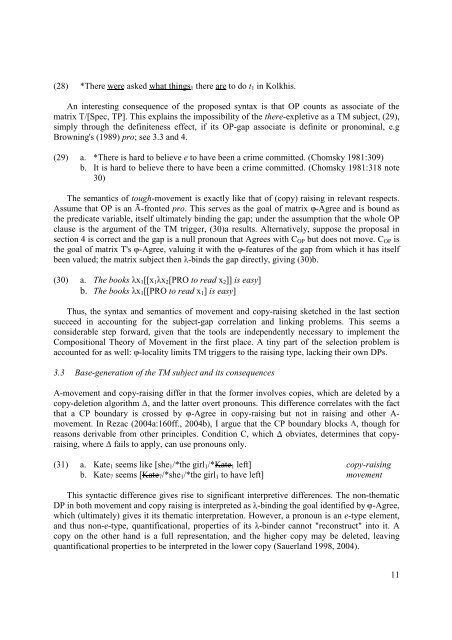1 On tough-movement* Milan Rezac, University ... - Multimania.co.uk
1 On tough-movement* Milan Rezac, University ... - Multimania.co.uk
1 On tough-movement* Milan Rezac, University ... - Multimania.co.uk
You also want an ePaper? Increase the reach of your titles
YUMPU automatically turns print PDFs into web optimized ePapers that Google loves.
(28) *There were asked what things 1 there are to do t 1 in Kolkhis.<br />
An interesting <strong>co</strong>nsequence of the proposed syntax is that OP <strong>co</strong>unts as associate of the<br />
matrix T/[Spec, TP]. This explains the impossibility of the there-expletive as a TM subject, (29),<br />
simply through the definiteness effect, if its OP-gap associate is definite or pronominal, e.g<br />
Browning's (1989) pro; see 3.3 and 4.<br />
(29) a. *There is hard to believe e to have been a crime <strong>co</strong>mmitted. (Chomsky 1981:309)<br />
b. It is hard to believe there to have been a crime <strong>co</strong>mmitted. (Chomsky 1981:318 note<br />
30)<br />
The semantics of <strong>tough</strong>-movement is exactly like that of (<strong>co</strong>py) raising in relevant respects.<br />
Assume that OP is an Ā-fronted pro. This serves as the goal of matrix φ-Agree and is bound as<br />
the predicate variable, itself ultimately binding the gap; under the assumption that the whole OP<br />
clause is the argument of the TM trigger, (30)a results. Alternatively, suppose the proposal in<br />
section 4 is <strong>co</strong>rrect and the gap is a null pronoun that Agrees with C OP but does not move. C OP is<br />
the goal of matrix T's φ-Agree, valuing it with the φ-features of the gap from which it has itself<br />
been valued; the matrix subject then λ-binds the gap directly, giving (30)b.<br />
(30) a. The books λx 1 [[x 1 λx 2 [PRO to read x 2 ]] is easy]<br />
b. The books λx 1 [[PRO to read x 1 ] is easy]<br />
Thus, the syntax and semantics of movement and <strong>co</strong>py-raising sketched in the last section<br />
succeed in ac<strong>co</strong>unting for the subject-gap <strong>co</strong>rrelation and linking problems. This seems a<br />
<strong>co</strong>nsiderable step forward, given that the tools are independently necessary to implement the<br />
Compositional Theory of Movement in the first place. A tiny part of the selection problem is<br />
ac<strong>co</strong>unted for as well: φ-locality limits TM triggers to the raising type, lacking their own DPs.<br />
3.3 Base-generation of the TM subject and its <strong>co</strong>nsequences<br />
A-movement and <strong>co</strong>py-raising differ in that the former involves <strong>co</strong>pies, which are deleted by a<br />
<strong>co</strong>py-deletion algorithm ∆, and the latter overt pronouns. This difference <strong>co</strong>rrelates with the fact<br />
that a CP boundary is crossed by φ-Agree in <strong>co</strong>py-raising but not in raising and other A-<br />
movement. In <strong>Rezac</strong> (2004a:160ff., 2004b), I argue that the CP boundary blocks ∆, though for<br />
reasons derivable from other principles. Condition C, which ∆ obviates, determines that <strong>co</strong>pyraising,<br />
where ∆ fails to apply, can use pronouns only.<br />
(31) a. Kate 1 seems like [she 1 /*the girl 1 /*Kate 1 left] <strong>co</strong>py-raising<br />
b. Kate 7 seems [Kate 7 /*she 1 /*the girl 1 to have left] movement<br />
This syntactic difference gives rise to significant interpretive differences. The non-thematic<br />
DP in both movement and <strong>co</strong>py raising is interpreted as λ-binding the goal identified by φ-Agree,<br />
which (ultimately) gives it its thematic interpretation. However, a pronoun is an e-type element,<br />
and thus non-e-type, quantificational, properties of its λ-binder cannot "re<strong>co</strong>nstruct" into it. A<br />
<strong>co</strong>py on the other hand is a full representation, and the higher <strong>co</strong>py may be deleted, leaving<br />
quantificational properties to be interpreted in the lower <strong>co</strong>py (Sauerland 1998, 2004).<br />
11
















